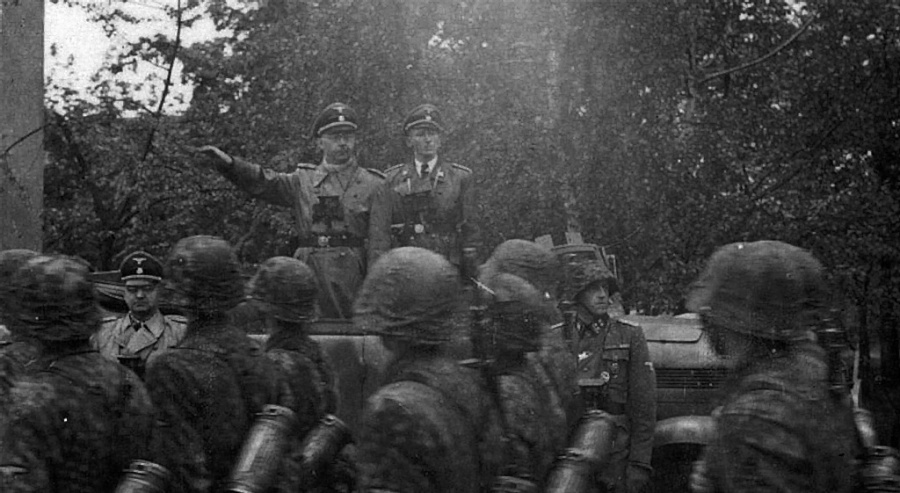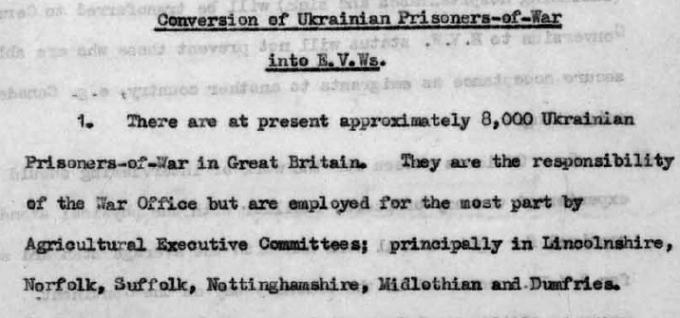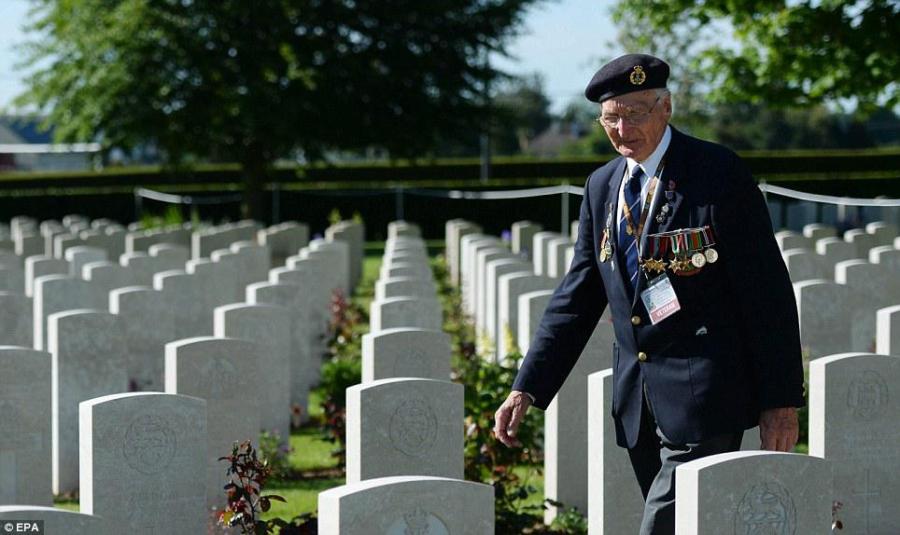Written by Andrey Panevin / Edited by @GBabeuf
Obstruction of Justice: How the British Government Protected 8,000 Soldiers of the Waffen-SS Galitsia Division

Ukrainian volunteers of the 14th Waffen Grenadier Division-SS Galitsia march past (L to R) Fritz Freitag, Heinrich Himmler and Otto Wachter
Amid the continued support given to the fascist politicians and military of Ukraine by western governments, many people are asking how such a betrayal of the sacrifices of the Allies in World War Two could take place. However, what most people are unaware of, in large part due to an ever-more corrupted media, is that these governments have a shocking history of protecting the perpetrators of some of the most terrible crimes of that war. One of the most egregious examples of this practice of shielding war-criminals from justice was confirmed in 2005 with the declassification of British Home Office papers showing that the British government protected at least 8,000 members of the Waffen-SS Galitsia Division from the justice that awaited them in the Soviet Union.
When Nazi Germany surrendered to the Allied Powers in May 1945, the 14th Waffen-SS ‘Galitsia’ Division, made up of Ukrainian volunteers, continued to retreat westward from their positions in Austria in order to avoid capture and punishment by the advancing Red Army. The Division—approximately 10,000 soldiers—ultimately chose to surrender to British and American forces and was briefly sent to an internment camp in Spittal an der Drau, Austria. The British government, in contravention of the agreements made at the Yalta Conference, refused to repatriate the Galitsia Division to the Soviet Union, instead transferring them to another internment camp in Bellaria-Igea Marina, in northern Italy. It was here that a troika of prominent Ukrainian fascists—Mykola Lebed, Father Ivan Hry’okh and Bishop Ivan Buchko—persuaded the Vatican to intercede on behalf of the soldiers, whom Bishop Buchko described as “good Catholics and fervent anti-communists.”

Galitsia Division troops interned at Rimini, Italy
As a result of this intercession, the British and American authorities overseeing the internment camp remained steadfast in their refusal to abide by their obligation to repatriate the soldiers to the Soviet Union. One of the principal British proponents of the decision not to repatriate the Galitsia Division was Major Denis Hills. Major Hills was keen on protecting these soldiers, and despite admitting that he “knew about the SS”, he said the army “was not interested in war crimes.” According to British academic, Stephen Dorril, in his book M16: Inside the Covert World of Her Majesty’s Secret Service, Major Hills was a self-described fascist and a staunch anti-communist who took it upon himself to ensure that the Galitsia Division would be transferred to Britain. Hills personally advised the head of the Division, Major Yaskevycz, to instruct his men that when questioned by the Soviet repatriation commission they must lie and insist that they were forced to serve alongside the Nazis and were not by any means volunteers. As a result of this, and due to British fears that improved relations between Italy and the Soviet Union could result in repatriation, the decision was made on April 1st, 1947, to relocate at least 8,000 members of the Galitsia Division to Britain.

Troops of Galitsia Division being transported to Britain
Documents from the British Home Office that were declassified in 2005 reveal in great detail the lengths to which government officials went to grant citizenship and employment to the members of the Galitsia Division. This was a process that was greatly encouraged by politicians of Ukrainian origin like Gordon Bohdan Panchuk, a Canadian MP who put significant pressure on the British Home Office to extend “kind and sympathetic understanding and favourable action” towards the Division. Panchuk further threatened Home Office officials that any discussions of repatriation or ill-treatment of the soldiers would result in a negative political reaction from the Ukrainian communities of Canada and Britain.
The Home Office documents also show a general awareness of the background of the men of the Galitsia Division. It was well known that the war record of these soldiers was “bad and difficulties are likely to arise if they are employed with Poles.” Despite this, the tendency within these correspondences was to overlook the recent history of the Galitsia Division and its role within the Waffen-SS. There were, however, notable objections from Home Office employees assigned to this matter, including that of Beryl Hughes, who found it:
difficult to understand the Ministry of Labour attitude over these POWs. To strain at the gnat of the PLF while appearing to be prepared to face with equanimity the prospect of swallowing a large-sized camel in the shape of upwards of 4,000 undisputed volunteers of the Wehrmacht seems to me the height of absurdity…I cannot help having serious misgivings about their attempt to foist the Ukrainian POWs on the labour market as just another batch of EVWs. [European Volunteer Workers].
Another Home Office official by the name of F.L.F Devey referred to the ‘Surrendered Enemy Personnel’ (SEP) status given to the Galitsia Division as a “pleasant fiction” that was originally enabled during their internment in Italy and overshadowed their true status as prisoners of war.

An interesting component to these documents, and particularly to the solicitations of the Canadian MP Panchuk, was the appeal to sympathy for the men of the Galitsia Division due to their fighting against Russians and communists rather than against “the western allies”. This logic would also be utilized by the CIA in later years, with high ranking operatives such as Harry Rositzke explaining that leading up to, and during, the Cold War anyone could be considered an ally “as long as he was anti-communist…you didn’t look at their credentials too closely.”

Even if there was an inclination to take a closer look at the credentials of the soldiers who made up the Galitsia Division, the British government had taken steps to obscure the dark history of these men. Dr. Stephen Ankier, a pharmacologist turned Holocaust researcher, brought to light the importance of the ‘Rimini list’. This was a classified document that disallowed the ability to track the members of the Division that were transferred to Britain and furthermore blocked efforts to “do anything about them, despite the suspicion that there were war criminals among that group, who were living in Britain.” One of the advantages of the Rimini list was that the British government would be able to better hide the identities of those former SS-Galitsia Division soldiers who would eventually join M16 and the British military in order to aid the anti-Soviet campaign.

An inquiry conducted by the former British MP, Rupert Allason, found that a significant number of the Division was taken to RNAS [Royal Naval Air Station ‒ed.] Crail in Scotland in order to aid with the teaching of the Russian language to British intelligence recruits. Furthermore Allason told the British parliament in 1990 that he had:
obtained evidence from people who served there [RNAS Crail] and were taught Russian by people who openly boasted about the atrocities they had committed…Those boasts were known to British national service men going into the Intelligence Corps and they must have been known to the British government in subsequent years.
Despite this evidence, that by many accounts was available to the British government for decades, no meaningful action was taken and there has been no official recognition of the British role in shielding thousands of war-criminals from justice. Even more shocking than this is the fact that the acceptance of WWII-era war criminals into Britain was not limited to these 8,000 Ukrainian fascists, but also allowed for the protection of a significant number of Axis soldiers. British historians Andrew Thompson and David Cesarani have in their research shown that “war criminals of a range of nationalities did enter Britain” through avenues such as post-war workers’ programs and resettlement initiatives that sought to prevent repatriation to Soviet territories.

In light of this information the logic of contemporary western support for fascism in Ukraine becomes clearer, especially in the context of the contemporary Russophobic hysteria which relies so heavily on post-WWII anti-Soviet rhetoric. Images of British and American politicians embracing the defenders of Ukraine’s fascist past were shocking at first, but now can be seen as the continuation of a decades-long political tradition that betrays the true heroes and victims of the Second World War.




Reblogged this on Susanna Panevin.
LikeLike
Posted by susannapanevin | Nov 20, 2016, 21:37Perfidious Albion at work, it seems.
When the subjects were Russians (cosacks), the perfidy was the other way round:
“On 28 May 1945, the British Army arrived at Camp Peggetz, in Lienz, where there were 2,479 Cossacks, including 2,201 officers and soldiers.[11] They went to invite the Cossacks to an important conference with British officials, informing them that they would return to Lienz by six o’clock that evening; some Cossacks worried, but the British reassured them that everything was in order. One British officer told the Cossacks: “I assure you, on my word of honour as a British officer, that you are just going to a conference”.[11] By then, British–Cossack relationships were friendly to the extent that many on both sides had developed feelings for the other. The Lienz Cossack repatriation was exceptional, because the Cossacks forcefully resisted their British repatriation to the USSR; a Cossack noted: “The NKVD or the Gestapo would have slain us with truncheons, the British did it with their word of honour.”[11]
The first to commit suicide, by hanging, was the Cossack editor Evgenij Tarruski. The second was General Silkin, who shot himself. . . . The Cossacks refused to board the trucks. British soldiers [armed] with pistols and clubs began using their clubs, aiming at the heads of the prisoners. They first dragged the men out of the crowd, and threw them into the trucks. The men jumped out. They beat them again, and threw them onto the floor of the trucks. Again, they jumped out. The British then hit them with rifle butts until they lay unconscious, and threw them, like sacks of potatoes, in the trucks. — Operation Keelhaul (1973), by Julius Epstein.
The British transported the Cossacks to a prison where the Soviets assumed their custody. In the town of Tristach, Austria, there is a memorial commemorating General von Pannwitz and the soldiers of the XV SS Cossack Cavalry Corps who were killed in action or died as POWs.[citation needed]”
https://en.wikipedia.org/wiki/Repatriation_of_Cossacks_after_World_War_II
Better ?
Cheers
LikeLike
Posted by Christoph | Nov 21, 2016, 08:42Reblogged this on Worldtruth.
LikeLike
Posted by mohandeer | Nov 21, 2016, 19:17Why end this off with a photo of a British vet in an allied war cemetery? SS Waffen Grenadier Division ‘Galizien’ Nr 14 wouldn’t qualify for either.
LikeLiked by 1 person
Posted by Baldur Dasche | Nov 21, 2016, 20:55Thank you for an excellent and important piece of historical research that exposes the extent of the British and Vatican collusion with fascism, and how the contemporary Obama-led anti-Russian racism, with its roots in Ukrainian neo-Nazism, is firmly linked to the past, and not a ‘new’ phenomenon,
LikeLiked by 1 person
Posted by Adrian Chan-Wyles (PhD) | Nov 23, 2016, 11:30Reblogged this on The Sangha Kommune. and commented:
Thank you for an excellent and important piece of historical research that exposes the extent of the British and Vatican collusion with fascism, and how the contemporary Obama-led anti-Russian racism, with its roots in Ukrainian neo-Nazism, is firmly linked to the past, and not a ‘new’ phenomenon,
LikeLike
Posted by Adrian Chan-Wyles (PhD) | Nov 23, 2016, 11:31Italian translation at:
https://noicomunisti.wordpress.com/2016/11/25/la-giustizia-ostacolata-come-8-000-soldati-della-divisione-waffen-ss-galitsien-furono-protetti-dal-governo-britannico/
LikeLike
Posted by noicomunisti | Nov 25, 2016, 16:54Perfidious Albion at work, it seems.
When the subjects were Russians (cosacks), the perfidy was the other way round:
“On 28 May 1945, the British Army arrived at Camp Peggetz, in Lienz, where there were 2,479 Cossacks, including 2,201 officers and soldiers.[11] They went to invite the Cossacks to an important conference with British officials, informing them that they would return to Lienz by six o’clock that evening; some Cossacks worried, but the British reassured them that everything was in order. One British officer told the Cossacks: “I assure you, on my word of honour as a British officer, that you are just going to a conference”.[11] By then, British–Cossack relationships were friendly to the extent that many on both sides had developed feelings for the other. The Lienz Cossack repatriation was exceptional, because the Cossacks forcefully resisted their British repatriation to the USSR; a Cossack noted: “The NKVD or the Gestapo would have slain us with truncheons, the British did it with their word of honour.”[11]
The first to commit suicide, by hanging, was the Cossack editor Evgenij Tarruski. The second was General Silkin, who shot himself. . . . The Cossacks refused to board the trucks. British soldiers [armed] with pistols and clubs began using their clubs, aiming at the heads of the prisoners. They first dragged the men out of the crowd, and threw them into the trucks. The men jumped out. They beat them again, and threw them onto the floor of the trucks. Again, they jumped out. The British then hit them with rifle butts until they lay unconscious, and threw them, like sacks of potatoes, in the trucks. — Operation Keelhaul (1973), by Julius Epstein.
The British transported the Cossacks to a prison where the Soviets assumed their custody. In the town of Tristach, Austria, there is a memorial commemorating General von Pannwitz and the soldiers of the XV SS Cossack Cavalry Corps who were killed in action or died as POWs.[citation needed]”
https://en.wikipedia.org/wiki/Repatriation_of_Cossacks_after_World_War_II
Better ?
Cheers
LikeLike
Posted by Christoph | Dec 4, 2016, 14:49My father, who had escaped German prison camps in WWI when he was an officer in the Preobrazhensky Regiment and in WWII as an officer of the British Intelligence corps, had become something of an expert at escaping (as well as springing fellow soldiers from) prison camps, upon learning that the Soviet prisoners who had been liberated by the British forces from German camps just after WWII and taken to a literal prison camp in Scotland and that the British were preparing to send them back to the USSR, and knowing that Stalin would have them all executed once they were back in the USSR, went against orders and used his expertise to help a whole bunch of them escape from Scotland and have them smuggled to the USA. Unfortunately, I have no other references which would have allowed me to trace any of these lucky men whom my father helped survive and live in the USA.
LikeLike
Posted by vierotchka | Mar 14, 2017, 19:42Reblogged this on Where do We go from Here? and commented:
Let’s not forget!
LikeLike
Posted by Sisyphus47 | Feb 6, 2017, 15:34Reblogged this on Unhappy is the land without heroes!.
LikeLike
Posted by atakti | Feb 8, 2017, 11:44As the daughter, sister and cousin of true (Pre-Revolution Russian, then Stateless, then Naturalized) British WWII war heroes, this saddens me profoundly.
LikeLike
Posted by vierotchka | Mar 14, 2017, 19:27Hello
Fascinating post but there is one thing I do not understand. The original type written do called ‘Rimini List’ is currently held at offices of the Association of Ukrainians in Great Britain where it has been kept since this Division was brought to the UK in 1949, and has as far as I know always been available to the public for inspection, (I myself first viewed it in 1991), plus of course the same document is available and was for many years in the former Berlin Document Centre and even online on a Russian based archive site, so why do you give the impression that there was no access to this document and consequently no action could be taken by the British government?
Best wishes
Mike Melnyk
LikeLike
Posted by Mike Melnyk | Jan 27, 2019, 07:45